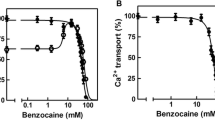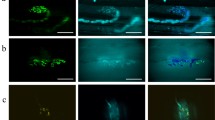Abstract
DENERVATION of skeletal muscles causes a spread of acetyl-choline (ACh) sensitivity along muscle fibres, but it is not yet clear whether this results from muscle inactivity or from a loss of trophic influence of the nerve on the muscle1. It has been suggested that inactivity is responsible for the phenomenon because the application of a cuff containing a local anaesthetic to a nerve blocked the conduction of the nerve impulses and caused the development of widespread sensitivity to ACh (ref. 2, but see ref. 3). The local anaesthetics used in that study, however, have since been shown to block axoplasmic transport in vitro4,5 and in vivo6, as well as to induce neuronal degeneration7. Axoplasmic transport seems to be involved in the trophic influence of the nerve on muscle because blocking this transport induces spreading of ACh sensitivity in muscle fibres8,9. We have used tetrodotoxin (TTX), incorporated into silicone cuffs placed around motor nerves, to test whether the resultant inactivity induced a spread of ACh sensitivity in skeletal muscle, as inferred from the binding of α-bungarotoxin (α-BuTX). TTX was chosen because it does not block axoplasmic transport in vitro5.
Similar content being viewed by others
References
Harris, A. J., A. Rev. Physiol., 36, 251–305 (1974).
Lømo, T., and Rosenthal, J., J. Physiol Lond., 221, 493–513 (1972).
Robert, E. D., and Oester, Y. T., J. Pharmac. exp. Ther., 174, 133–140 (1970).
Fink, B. R., Kennedy, R. D., Hendrickson, A. E., and Middaugh, M. E., Anesthesiology, 36, 422–432 (1972).
Anderson, K.-E., and Edström, A., Brain Res., 50, 125–134 (1973).
Bisby, M. A., Expl Neurol., 47, 481–489 (1975).
Blunt, R. J., and Vrbová, G., Pflügers Arch. Eur. J. Physiol., 357, 187–199 (1975).
Hofmann, W. W., and Thesleff, S., Eur. J. Pharmac., 20, 256–260 (1972).
Albuquerque, E. X., Warnick, J. E., Tasse, J. R., and Sansome, F. M., Expl Neurol., 37, 607–634 (1972).
Berg, D. K., Kelly, R. B., Sargent, P. B., Williamson, P., and Hall, Z. W., Proc. natn. Acad. Sci. U.S.A., 69, 147–151 (1972).
Kása, P., Mann, S. P., Karcsu, S., Toth, L., and Jordan, S., J. Neurochem., 21, 431–436 (1973).
Ellman, G. L., Courtney, D., Andres, V., Jr, and Featherstone, R. M., Biochem. Pharmac., 7, 88–95 (1961).
Author information
Authors and Affiliations
Rights and permissions
About this article
Cite this article
LAVOIE, PA., COLLIER, B. & TENENHOUSE, A. Comparison of α-bungarotoxin binding to skeletal muscles after inactivity or denervation. Nature 260, 349–350 (1976). https://doi.org/10.1038/260349a0
Received:
Accepted:
Issue Date:
DOI: https://doi.org/10.1038/260349a0
- Springer Nature Limited
This article is cited by
-
Terminal nerve sprouting at the frog neuromuscular junction induced by prolonged tetrodotoxin blockade of nerve conduction
Journal of Neurocytology (1989)
-
Role of calcium ions and spike activity in the neurotrophic control of membrane potential in rat muscle fibers
Neurophysiology (1988)
-
Temporal relationship between nerve-stump-length-dependent changes in the autophosphorylation of a cyclic AMP-dependent protein kinase and the acetylcholine receptor content in skeletal muscle
Neurochemical Research (1988)
-
Effect of postsynaptic blockade of neuromuscualar transmission on properties of the frog fast muscle fiber membrane
Neurophysiology (1984)





